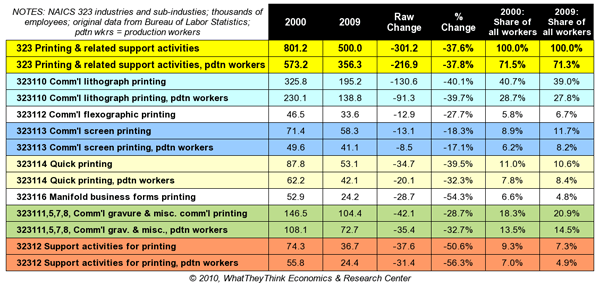Last week, the Bureau of Labor Statistics published their latest data, and revisions or prior years, of the number of employees in our industries. Since December 2000, the printing industry (NAICS 323) has declined by about 300,000 employees, or a bit more that -37%. In that same period, the number of all non-farm employees in the entire economy fell by about -2.2%. In terms of employees involved in the manufacturing of non-durable goods, printing went from about 9% of those workers, to 8%.
As discussed in some prior posts, the number of workers in agencies, design, and publishing industries increased by an amount similar to the decline, but even that has changed recently. Newspaper employment has suffered greatly the past two years, and we have seen declines in content creation businesses like agencies and graphic design as well. The decline in these two businesses have been less than in printing, an indication of the shift in media the use of media. We will discuss the changes there in a future posting.
Comparing 2000 and 2009, the ratio of production workers to the total is about the same, at 71.3% of all employees. The niche that had the lowest rate of decline was commercial screen printing, possibly the result of promotional goods and display items. The biggest declines were in business forms (no surprise) and trade services such as prepress and postpress (more than -50%). Prepress businesses became printers (many digital), or graphic design, or something else. Postpress businesses found specialty niches, but many closed as printers left downtown areas and no longer had easy access to postpress businesses and then invested in their own postpress capabilities in their new facilities.
One may wonder why digital printing businesses are not in this list. They are: in miscellaneous. As best we can estimate from other Census sources, digital printing are about 45% of the employees in that category, and probably have been the only growth segment in the entire chart, but are masked by declines in gravure, book printing, and other segments that have been banished to miscellaneous. More detailed data for 2009 won't be available for years, most likely. There are, of course, many employees involved in digital printing in the other segments where digital output is still not the majority of their revenues. Since printing employees have gone from representing 0.6% of total U.S. employment in 2000 to 0.38% in 2009, it is more likely that data about our industry will become “rolled up” into less detailed categories than into more detailed ones.
What's ahead? The media shifts that are playing out are creating new niches, many of which are not tracked directly by the BLS or other Census Department. We shouldn't expect that they would be. Industries or product categories have to rise to a detectable and significant level before the Census can commit resources to them, but there is a larger and more important issue.
You can never get data on innovation. As I told a client years ago, when they asked for hard data for a product that was just coming to the marketplace, “if you want hard data, you can have all you want as long as it's about a large, old, and declining industry.”
Entrepreneurs know that no data will fit their needs like a custom-made glove. If it can be precisely measured before it's invented, it's not entrepreneurship. Sitting around waiting for hard data only gives time to competitors who have no time for waiting, only time for innovation. While the employment data only affirm what we already suspected, we are still a large industry that still needs employees; we are still in a marketplace with unmet communications needs. Those needs are quite different than they used to be, many of them are not print-intensive, and that is where the opportunities remain.
NOTE ABOUT THE TABLE: Data do not include printing workers in inplant/corporate printing departments, packaging (but does include labels & wrappers), printing workers in plants owned by newspaper publishers. Data do not include freelance workers, such as sole practitioner print brokers. Details of NAICS 323 can be found at the Census website.










